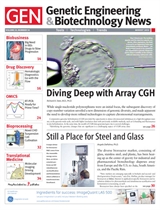Aug 27 2013
Researchers from Johns Hopkins and the National Cancer Institute (NCI) highlighted a novel mechanism underlying Parkinson's disease while simultaneously putting to rest a previously held theory regarding progression of the disorder. They also identified a compound that alleviates the disease's symptoms in mice.
The investigators describe their work in a paper titled "Parthanatos mediates AIMP2-activated age-dependent dopaminergic neuronal loss," published online in Nature Neuroscience.
"Not only were we able to identify the mechanism that could cause progressive cell death in both inherited and noninherited forms of Parkinson's, we found there were already compounds in existence that can cross into the brain and block this from happening," said Valina Dawson, Ph.D., director of the stem cell biology and neuroregeneration programs at the Johns Hopkins University School of Medicine's Institute for Cell Engineering (ICE). "While there are still many things that need to happen before we have a drug for clinical trials, we've taken some very promising first steps."
Dr. Dawson and her husband, Ted Dawson, M.D., Ph.D., the director of ICE, have collaborated for decades on studies of the molecular chain of events that lead to Parkinson's. One of their findings was that the function of an enzyme called parkin, which malfunctions in the disease, is to tag a bevy of other proteins for destruction by the cell's recycling machinery. This means that nonfunctional parkin leads to the buildup of its target proteins, and the Dawsons and others are exploring what roles these proteins might play in the disease.
In the new study, the Dawsons collaborated with Debbie Swing and Lino Tessarollo of the NCI to develop mice whose genes for a protein called AIMP2 could be switched into higher performance. AIMP2 is one of the proteins normally tagged for destruction by parkin, so the genetically modified mice enabled the research team to put aside the effects of defective parkin and excesses of other proteins and look just at the consequences of too much AIMP2.
They found that the mice developed symptoms similar to those of Parkinson's as they aged. The brain cells that make dopamine were dying. Since AIMP2 is known for its role in the process of making new proteins, the researchers thought the cell death was caused by problems with this process. But when graduate student Yunjong Lee looked at the efficiency of protein-making in the affected mice, everything appeared normal.
Searching for an alternative explanation, Lee tested how cells with excess AIMP2 responded to compounds blocking various paths to cell death and found that the AIMP2 was activating a self-destruct pathway called parthanatos, discovered and named by the Dawsons years ago.
Lee found that AIMP2 triggered parthanatos by directly interacting with a protein called PARP1, which was long thought to respond only to DNA damage and not to signals from other proteins. Dr. Valina Dawson notes that AIMP2 is actually the second protein found to activate PARP1, but the idea that PARP1 is only involved in detecting and responding to DNA damage is still firmly entrenched in her field.
Since the Dawsons had been studying PARP1 for some time, they knew of compounds drug companies had designed to block this enzyme. Such drugs are already in the process of being tested to protect healthy cells during cancer treatment.

 This article was reprinted from Genetic Engineering & Biotechnology News (GEN) with permission from Mary Ann Liebert, Inc., publishers. Genetic Engineering & Biotechnology News (GEN) has retained its position as the number one biotech publisher around the globe since its launch in 1981. GEN publishes a print edition 21 times a year and has additional exclusive editorial content online, like news and analysis as well as blogs, podcasts, webinars, polls, videos, and application notes. GEN's unique news and technology focus includes the entire bioproduct life cycle from early-stage R&D, to applied research including omics, biomarkers, as well as diagnostics, to bioprocessing and commercialization.
This article was reprinted from Genetic Engineering & Biotechnology News (GEN) with permission from Mary Ann Liebert, Inc., publishers. Genetic Engineering & Biotechnology News (GEN) has retained its position as the number one biotech publisher around the globe since its launch in 1981. GEN publishes a print edition 21 times a year and has additional exclusive editorial content online, like news and analysis as well as blogs, podcasts, webinars, polls, videos, and application notes. GEN's unique news and technology focus includes the entire bioproduct life cycle from early-stage R&D, to applied research including omics, biomarkers, as well as diagnostics, to bioprocessing and commercialization.